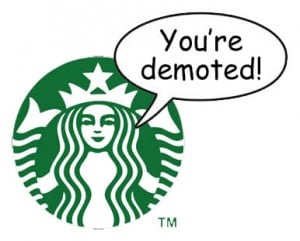Do you have the Starbucks app on your smart phone? I finally downloaded it to my phone just last week after having stopped at a Starbucks with a friend who had it. She was getting her free drink due to her Gold Card and I got intrigued to learn more about it. As many other big companies, Starbucks launched its loyalty card early in 2009. The idea behind creating a brand loyalty culture in a company is immensely valuable, as it guarantees customer loyalty and simultaneously gathers data of consumers, at the small cost of rewarding consumers with small gifts.
In Forbes, Roger Dooley case studies Starbucks’ loyalty program and finds a misfire. Dooley talks about Starbucks’ magnificent marketing techniques and their great job in cultivating a brand loyalty culture. He says “Like the airline loyalty programs it resembles, the Starbucks Gold Card program has to deal with customers whose consumption habits change… if you must cut benefits, you’d like to do it in the most sensitive way possible”. It is not the way Starbucks has gone about creating, managing and marketing their Gold Card program, it is the way they have removed benefits from less frequent customers that could be revisited.
As of now, when a customer frequents their coffee shops they accumulate points and get rewards in relation to their purchases. It only takes 30 stars to become a Gold Card member and to maintain that status, you must consume 30 stars on a yearly basis. If for instance, you open a card and for the first year accumulated 30 or more stars, you automatically become a Gold Card member. If the second year comes around and you fall short of the 30 new stars you were to achieve, Starbucks sends you an email informing you, in a rather cold way, you have been “demoted”.
Even though it is relatively easy to get your status back, this same email will continue informing you that “you’re back to Green for now, and your Star count has been reset”. Therefore, you fall down in level and zero out in points, it is a lose-lose situation for the brand loyal customer. It is interesting to see who even though this app sounds like a great way to incentive clients to visit their Starbucks coffee shop, it also seems like a one-way street. I say this because it seems that as long as you are loyal to Starbucks, Starbucks will be loyal to you. Because the moment you do not accumulate the 30 stars Starbucks requires to be in the Gold Card, it is as if you have never been a loyal customer and you start all over again with a Green card and zero stars.
Sources: http://www.forbes.com/sites/rogerdooley/2013/07/23/starbucks-gold/
Do you think it is right for Starbucks to simply zero out your account? What suggestions would you give to loyal customers who may feel frustrated? Do you have a Starbucks app? Are you a Gold Card member? What is your opinion?
